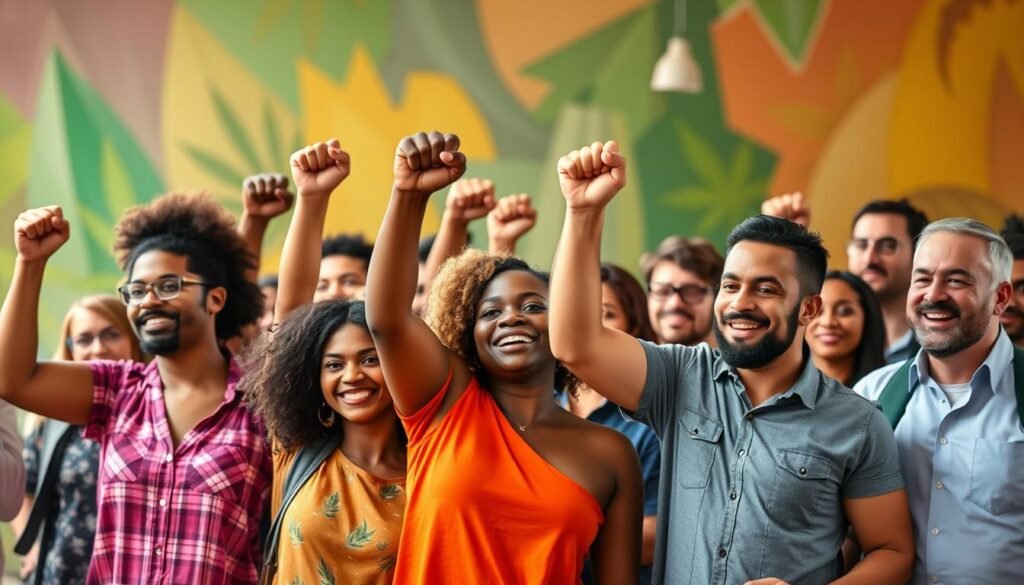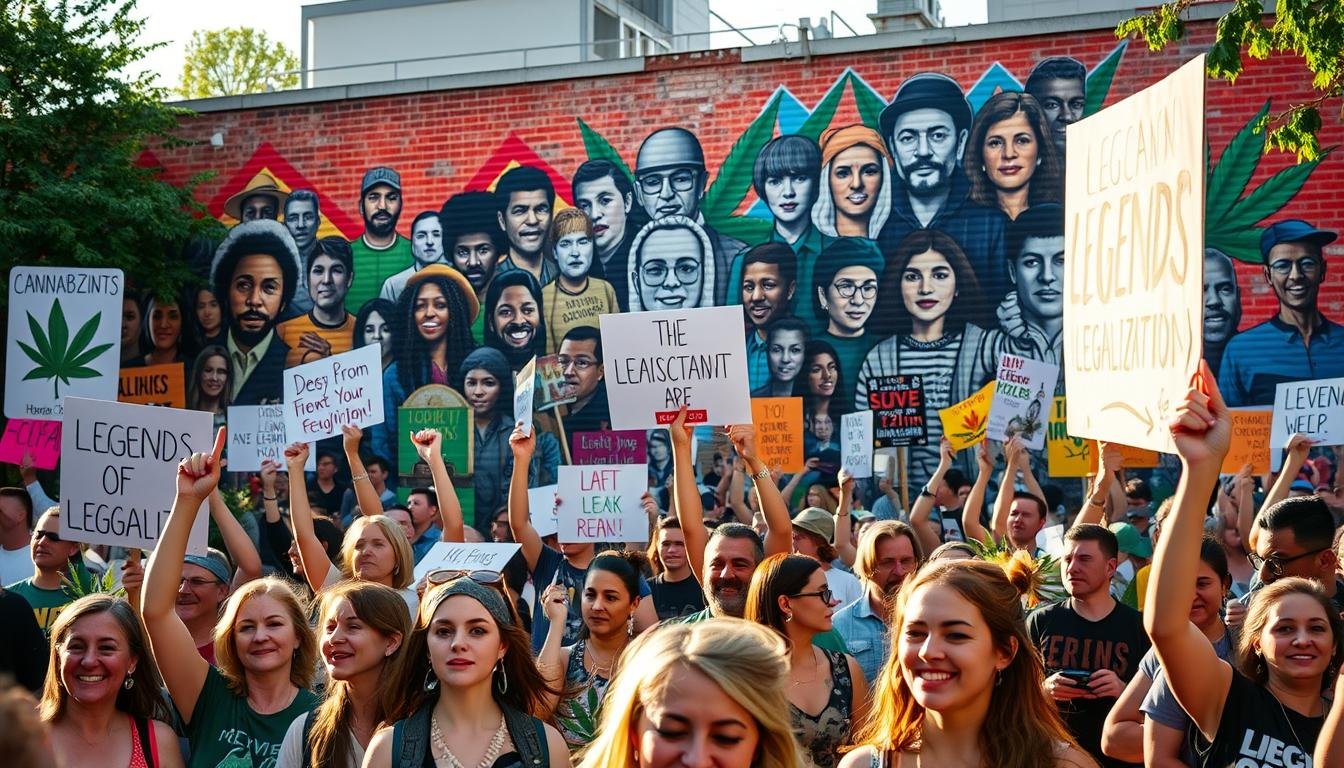What makes a movement challenge the status quo and change society? The fight for cannabis legalization shows the strength of never giving up and standing up for what’s right.
The history of cannabis legalization is filled with many players and key moments. At the heart are those who have given their all to the cause, facing big challenges along the way.
These are the tales of the heroes who have made a big difference. Their work has been key in shaping the cannabis legalization history we know today.
Key Takeaways
- The cannabis legalization movement is driven by dedicated individuals and organizations.
- The history of legalization is complex and multifaceted.
- Key figures have played a crucial role in advancing the cause.
- The movement has achieved significant milestones in recent years.
- Continued activism is necessary to achieve full legalization.
The Roots of Resistance: Early Cannabis Activism
The fight against cannabis prohibition started long ago. Early activists were there before it became a big issue. Knowing about the early days of cannabis culture helps us see how far we’ve come.
Pre-Prohibition Cannabis Culture in America
In the early 1900s, cannabis was everywhere in America. It was in medicines and people used it for fun. People from all walks of life enjoyed cannabis back then.
First Voices Against the Marijuana Tax Act of 1937
The Marijuana Tax Act of 1937 was a big step towards banning cannabis. But, not everyone agreed with it. Some spoke out early, worried about its misuse and its effects on users.
| Year | Event | Impact on Cannabis Culture |
|---|---|---|
| 1900s | Cannabis use becomes widespread | Diverse user base emerges |
| 1937 | Marijuana Tax Act passed | Prohibition begins, early activism starts |
| 1960s | Counterculture movement | Cannabis becomes a symbol of resistance |
The fight against cannabis prohibition started early. This activism is the foundation of today’s push for legalization. By learning from history, we can understand the journey and the hurdles we still face.
1960s Counterculture: When Cannabis Became Political
The 1960s counterculture was a key moment in American history. It greatly influenced how people saw cannabis. This era saw a big rise in cannabis use as a way to challenge mainstream values.
The counterculture of the 1960s rejected old norms and welcomed new lifestyles. Cannabis was at the heart of this movement, standing for rebellion and not following the crowd. Allen Ginsberg, a key figure of the Beat Generation, said, “The only thing that can save America is a return to the individual, a return to the personal.” This idea really connected with the counterculture, where using cannabis was seen as a way to stand up against the establishment.
The Beat Generation’s Influence
The Beat Generation set the stage for the 1960s counterculture. Writers like Jack Kerouac and William S. Burroughs wrote about alternative culture, including cannabis use. Their work showed the emerging counterculture and helped shape its identity.
Hippie Movement and Cannabis Symbolism
The hippie movement took the Beat Generation’s ideas even further. They made cannabis a symbol of peace, love, and rebellion. As the movement grew, so did the link between cannabis and political activism. Many saw using cannabis as a way to protest against mainstream culture and the status quo.
In the words of
“Cannabis is not just a plant, it’s a symbol of resistance.”
This quote captures the spirit of the 1960s counterculture. In this era, cannabis was more than just a substance. It was a symbol of a larger cultural and political movement.
Jack Herer: The Emperor of Hemp
Jack Herer, known as the “Emperor of Hemp,” was a key figure in the fight for cannabis legalization. He educated many about cannabis’s benefits. He also brought people together for the cause.
The Man Behind “The Emperor Wears No Clothes”
Herer’s biggest achievement is his book, “The Emperor Wears No Clothes.” It’s a detailed look at cannabis history and its uses. Published in 1985, it’s a key text in cannabis studies.
The book talks about cannabis’s uses, from industrial to medicinal. It makes a strong case for legalizing it.
Herer’s Lasting Impact on Cannabis Education
Jack Herer’s work has had a lasting impact on cannabis education. His book is still a go-to for learning about cannabis.
- Educated the public about cannabis benefits
- Influenced cannabis policy and legislation
- Inspired a new generation of cannabis activists
Herer’s impact as a cannabis hero is clear. His work will be remembered for years to come.
Dennis Peron and Brownie Mary: Medical Marijuana Pioneers
In San Francisco, Dennis Peron and Brownie Mary led the medical marijuana movement. They worked hard to change how people saw and used medical marijuana.
San Francisco’s Cannabis Compassion Movement
Dennis Peron started the Cannabis Compassion Movement. It aimed to help people with illnesses using cannabis. This movement got support from locals and caught the nation’s eye.
Proposition 215 and California’s Watershed Moment
Thanks to their activism, Proposition 215 passed in California. This law allowed medical marijuana use, a big step in marijuana’s history. It changed how marijuana was seen legally.
“The passage of Proposition 215 was a beacon of hope for many patients who had been suffering in silence.”
Mary Jane Rathbun’s AIDS Activism Through Edibles
Brownie Mary, or Mary Jane Rathbun, made cannabis edibles for AIDS patients. Her work eased their pain and showed cannabis’s compassionate side.
Together, Dennis Peron and Brownie Mary made a big impact on medical marijuana. Their work helped pave the way for more acceptance and legalization.
Cannabis Legalization History, Weed Activism, and Cannabis Heroes Fighting for Stoner Rights
The journey to legalize cannabis is filled with activism and advocacy. It’s a long path, with many groups and individuals fighting for change. They’ve shaped the movement into what it is today.
NORML and the Birth of Organized Advocacy
The National Organization for the Reform of Marijuana Laws (NORML) is key in the fight for legalization. Started in 1970, NORML has been a strong voice for cannabis users. They push for laws that support them.
Women of Color Leading Reform Movements
Women of color lead the way in cannabis reform. They focus on how prohibition hurts communities of color. Their work aims for fair policies and justice in the cannabis world.
The Shafer Commission and Early Policy Challenges
The Shafer Commission was set up in 1970 to study cannabis. Their findings and advice were crucial for early policy talks. They helped pave the way for future legalization efforts.
| Organization/Initiative | Year Established | Key Contributions |
|---|---|---|
| NORML | 1970 | Advocacy, legislative reform |
| Shafer Commission | 1970 | Comprehensive study, policy recommendations |
| Women of Color Reform Movements | Ongoing | Social justice, equitable policies |
The history of cannabis legalization shows the power of activism. Groups like NORML, women of color, and the Shafer Commission are vital. They keep pushing for stoner rights.
Dr. Raphael Mechoulam and the Science of Cannabis
Dr. Raphael Mechoulam has made huge strides in cannabis science. He found THC and the endocannabinoid system. His work has helped us understand cannabis better and supports its use.
Discovering THC and the Endocannabinoid System
In the 1960s, Dr. Mechoulam found THC, the main psychoactive part of cannabis. This was a big step in studying cannabis. He also found out how cannabis works in our bodies.

How Scientific Research Legitimized Cannabis Advocacy
Dr. Mechoulam’s research has made a big difference. It showed how cannabis works, moving from stories to science. This has helped make cannabis legal in more places.
| Year | Discovery | Impact |
|---|---|---|
| 1964 | Isolation of THC | Identified the primary psychoactive compound in cannabis |
| 1980s | Discovery of the Endocannabinoid System | Revealed the complex mechanisms by which cannabis interacts with the human body |
| 1990s | Further Research on Cannabinoids | Expanded understanding of cannabis’s therapeutic potential |
Legal Warriors: The Court Battles for Cannabis
Many legal warriors have fought in court to change cannabis laws. This section looks at key court battles that have changed the cannabis world.
Robert Randall and Medical Necessity
Robert Randall’s case was a big moment in cannabis history. He had glaucoma and needed cannabis to treat it. He won his case, showing courts that cannabis can be medically necessary.
This victory helped change laws about medical marijuana.
ACLU and Drug Policy Alliance’s Strategic Litigation
The ACLU and Drug Policy Alliance have led the fight against unfair cannabis laws. They fight for people’s rights and push for policy changes in court.
Landmark Court Decisions That Changed Everything
Many court decisions have greatly affected cannabis laws. These decisions have changed laws and influenced public opinion. They’ve also helped push for more legalization.
- United States v. Randall: Showed that cannabis can be medically necessary.
- Conant v. Walters: Protected doctors’ right to recommend cannabis.
- Other significant cases that have helped change cannabis laws.
These court battles have been key in the fight for cannabis rights in the U.S. They show how important legal warriors are in this fight.
Political Champions: From Fringe to Mainstream
Courageous political advocates have led the way in making cannabis mainstream. They have shaped the legal landscape around cannabis in the United States.
Early Political Advocates Who Risked Their Careers
In the early days, cannabis activists faced a lot of backlash. Rep. Ron Paul was a pioneer, introducing decriminalization bills in 1977. Despite the risks, they set the stage for future advocates.
Bernie Sanders, Cory Booker, and Modern Political Support
Today, Bernie Sanders and Cory Booker lead the charge for cannabis reform. They’ve introduced bills to fix the injustices of cannabis prohibition. Their work has made talking about legalization more common.
The Congressional Cannabis Caucus
The Congressional Cannabis Caucus is a big step forward. It shows there’s real political will to change cannabis laws. The caucus works to educate and pass laws that support legalization.
| Political Champion | Contribution |
|---|---|
| Rep. Ron Paul | Introduced legislation to decriminalize marijuana in 1977 |
| Bernie Sanders | Supports legislation to end federal cannabis prohibition |
| Cory Booker | Introduced the Marijuana Justice Act to address social justice issues related to cannabis |
State-Level Heroes: The Architects of Legalization
Colorado and Washington led the way in legalizing cannabis. This change was a big step in how the country views drugs. It showed that making cannabis legal could work well, encouraging other places to try it too.
Colorado and Washington’s First Movers
In 2012, Colorado and Washington became the first to allow recreational cannabis. This move was a big step for others to follow. It came after years of hard work by local supporters.
Key Players in Colorado and Washington:
- Campaign leaders who organized the ballot initiatives
- Local activists who taught people about cannabis legalization’s benefits
- Politicians who backed the law and helped it pass
Local Activists Who Made State Ballots Happen
Local activists were key to making cannabis legal. They spent a lot of time getting signatures, raising money, and getting people to support the ballot. Their hard work was crucial.

Indigenous Leaders and Tribal Cannabis Sovereignty
Indigenous leaders also played a big part in the cannabis movement. They fought for the right to grow and sell cannabis on tribal lands. This was a way to protect their sovereignty.
| State | Tribal Nation | Cannabis Program |
|---|---|---|
| Washington | Suquamish Tribe | Retail Sales |
| Oregon | Confederated Tribes of Grand Ronde | Cultivation and Retail |
| California | Grindstone Rancheria | Cannabis Manufacturing |
The work of state heroes, including local activists and indigenous leaders, has shaped the cannabis legalization movement. Their efforts keep pushing for full legalization in the U.S.
The Cultural Icons Who Normalized Cannabis
Cultural icons have led the way in making cannabis use more accepted. Their influence has changed how people see cannabis, making it more mainstream.
Willie Nelson, Snoop Dogg, and Celebrity Advocacy
Celebrities like Willie Nelson and Snoop Dogg have spoken out for cannabis. Willie Nelson has promoted cannabis through his advocacy and business, like Willie Nelson’s Sea of Green. Snoop Dogg, with his relaxed vibe and cannabis-friendly content, has also helped make it more normal.
How Entertainment Changed Public Opinion
The entertainment world has greatly influenced how we view cannabis. Movies, music, and TV shows have shown cannabis in a positive or neutral way. This has helped make it more accepted.
Athletes and Cannabis Destigmatization
Athletes have also played a part, talking about cannabis’s benefits for pain and recovery. This has helped remove the stigma from cannabis in sports and elsewhere.
The work of these cultural icons has been key in changing how we see cannabis. They have helped pave the way for more legalization and acceptance.
Digital Activism and Social Media Warriors
The cannabis legalization movement has found a new frontier in digital activism. Social media platforms and online communities are key tools for advocates. They help mobilize support, share information, and push for policy changes.
How Technology Transformed the Movement
Technology has changed how cannabis legalization efforts are organized and executed. Social media platforms like Twitter, Facebook, and Instagram help activists reach more people. They share their stories and mobilize support fast.
Online petitions, crowdfunding campaigns, and virtual protests are now common. These strategies help the movement grow.
Cannabis Influencers and Online Communities
Cannabis influencers and online communities shape public opinion and promote cannabis culture. These influencers educate their followers about cannabis benefits. They share their personal experiences and advocate for legalization.
Online forums and social media groups offer spaces for discussing cannabis issues. They share resources and support each other.
Data Transparency and the Fight Against Misinformation
One big challenge in the cannabis legalization movement is fighting misinformation. Data transparency is key in this fight. By making data accessible, activists can counter false narratives with evidence-based arguments.
This transparency builds trust within the community and with the public.
In conclusion, digital activism and social media have changed the cannabis legalization movement. They offer new ways for advocacy and community building. As the movement grows, technology will likely play an even bigger role in its future.
Conclusion: The Ongoing Fight for Full Legalization
The journey to full cannabis legalization is far from over. We’ve made big steps, but there’s still a lot to do. The cannabis heroes who have paved the way have laid a crucial foundation, but more work remains to achieve complete legalization.
Their efforts have brought us to a point where cannabis is increasingly accepted, but full legalization requires continued advocacy. As we move forward, it’s essential to build on the momentum generated by pioneers in the cannabis movement.
The ongoing fight for full legalization demands that we remain committed to the cause. By supporting cannabis legalization efforts, we can create a more just and equitable society. The cannabis heroes who have come before us have shown us the way; now it’s our turn to carry the torch forward.
FAQ
What is the history behind cannabis legalization?
The journey to legalize cannabis is long and complex. It started with early activism and cultural movements. Key figures like Jack Herer, Dennis Peron, and Dr. Raphael Mechoulam played important roles.
What was the Marijuana Tax Act of 1937?
The Marijuana Tax Act of 1937 banned cannabis use, sale, and transport. It sparked resistance and activism against prohibition.
How did the 1960s counterculture influence cannabis activism?
The 1960s counterculture, including the Beat Generation and hippie movement, changed how people saw cannabis. It became a symbol of dissent and rebellion.
What was the impact of Proposition 215 on California’s medical marijuana landscape?
Proposition 215, passed in 1996, allowed medical cannabis use in California. It set a precedent for other states to follow.
Who is NORML, and what role did they play in cannabis advocacy?
NORML, or the National Organization for the Reform of Marijuana Laws, has led cannabis advocacy since the 1970s. They push for cannabis legalization.
What is the significance of Dr. Raphael Mechoulam’s research on cannabis?
Dr. Raphael Mechoulam’s research, including THC discovery and the endocannabinoid system, legitimized cannabis advocacy. It advanced cannabis science.
How have cultural icons contributed to the normalization of cannabis?
Celebrities like Willie Nelson and Snoop Dogg have helped normalize cannabis. They’ve helped change public opinion and reduce stigma.
What is the role of digital activism and social media in the cannabis legalization movement?
Digital activism and social media have changed the cannabis movement. They enable advocacy, mobilization, and community-building. They also provide a platform for influencers and communities.
What is the current state of cannabis legalization in the United States?
The U.S. has made progress in cannabis legalization. Many states allow medical or recreational use. Yet, the fight for full federal legalization continues. Efforts are ongoing to address challenges and disparities.

